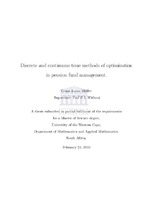| dc.description.abstract | Pensions are essentially the only source of income for many retired workers. It is thus critical that the pension fund manager chooses the right type of plan for his/her workers.Every pension scheme follows its own set of rules when calculating the benefits of the fund’s members at retirement. Whichever plan the manager chooses for the members,he/she will have to invest their contributions in the financial market. The manager is therefore faced with the daunting task of selecting the most appropriate investment strat-egy as to maximize the returns from the financial assets. Due to the volatile nature of stock markets, some pension companies have attached minimum guarantees to pension contracts. These guarantees come at a price, but ensure that the member does not suffer
a loss due to poorly performing equities.In this thesis we study four types of mathematical problems in pension fund management,of which three are essentially optimization problems. Firstly, following Blake [5], we show in a discrete time setting how to decompose a pension benefit into a combination of Euro-pean options. We also model the pension plan preferences of workers, sponsors and fund
managers. We make a number of contributions additional to the paper by Blake [5]. In particular, we contribute graphic illustrations of the expected values of the pension fund assets, liabilities and the actuarial surplus processes. In more detail than in the original source, we derive the variance of the assets of a defined benefit pension plan. Secondly,we dedicate Chapter 6 to the problem of minimizing the cost of a minimum guarantee included in defined contribution (DC) pension contracts. Here we work in discrete time and consider multi-period guarantees similar to those in Hipp [25]. This entire chapter is original work. Using a standard optimization method, we propose a strategy that cal- culates an optimal sequence of guarantees that minimizes the sum of the squares of the present value of the total price of the guarantee. Graphic illustrations are included to in-dicate the minimum value and corresponding optimal sequence of guarantees. Thirdly, we
derive an optimal investment strategy for a defined contribution fund with three financial assets in the presence of a minimum guarantee. We work in a continuous time setting and in particular contribute simulations of the dynamics of the short interest rate process and the assets in the financial market of Deelstra et al. [19]. We also derive an optimal investment strategy of the surplus process introduced in Deelstra et al. [19]. The results regarding the surplus are then converted to consider the actual investment portfolio per- taining to the wealth of the fund. We note that the aforementioned paper does not use optimal control theory. In order to illustrate the method of stochastic optimal control, we study a fourth problem by including a discussion of the paper by Devolder et al. [21] in Chapter 3. We enhance the work in the latter paper by including some simulations. The specific portfolio management strategies are applicable to banking as well (and is being
pursued independently). | en_US |

